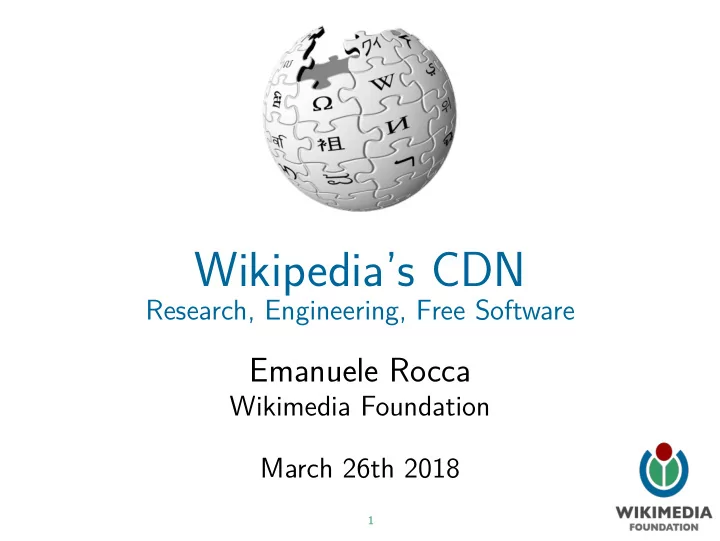

Wikipedia’s CDN Research, Engineering, Free Software Emanuele Rocca Wikimedia Foundation March 26th 2018 1
How does Wikipedia end up on my screen? 1
Outline 2 ▶ Wikimedia Foundation ▶ CDN Ingredients ▶ In Practice
Wikimedia Foundation 3
Wikimedia Foundation Non-profjt organization focusing on free, open-content, wiki-based Internet projects. 4
WMF: what it does NOT do 5 ▶ Edit Wikipedia ▶ Use advertisement or VC money
WMF: what it does 6 ▶ Owns the wikipedia.org domain ▶ Raises money through donations ▶ Controls the servers (19 Site Reliability Engineers) ▶ Develops and deploys software (66 SWE)
Alexa Top Websites $13.4 billion 100,000+ 8,500 $1.31 billion Yahoo 1,000+ 304 $81.9 million Wikimedia 100,000+ 46,391 Baidu Company 180,000+ 25,105 $40.6 billion Facebook 2,000,000+ 73,992 $89.4 billion Google Server count Employees Revenue 7
Traffjc Volume 8 ▶ Average: ~100k/s, peaks: ~140k/s ▶ Can handle more for huge-scale DDoS attacks
DDoS Example Source: jimieye from fmickr.com (CC BY 2.0) 9
The Wikimedia Family 10
Values movements open-source components volunteers 11 ▶ Deeply rooted in the free culture and free software ▶ Infrastructure built exclusively with free and ▶ Design and build in the open, together with
Build In The Open 12 ▶ github.com/wikimedia ▶ gerrit.wikimedia.org ▶ phabricator.wikimedia.org ▶ grafana.wikimedia.org
CDN Ingredients 13
How does Wikipedia end up on my screen? 14
15
Thank you! Any questions? 16
CDN Ingredients 17 ▶ HTTP Caching ▶ Load balancing
Caching proxies Reduce application server load by caching HTTP responses 18
19
20
The devil is in the detail The cache receives multiple requests for the same page before receiving a response from the server. What should it do? 21
22
23
The devil is in the detail How about your bank account! 24
25
26
Response headers Cache-Control: private 27 ▶ The response is intended for a single user ▶ Shared caches must not store it
28
29
Paper: Hypertext Transfer Protocol (HTTP/1.1): Caching Fielding, R., Ed., Nottingham, M., Ed., and J. Reschke, Ed., Hypertext Transfer Protocol (HTTP/1.1): Caching RFC 7234, June 2014. 30
evenly Load balancing 31 ▶ One caching proxy is of course not enough ▶ Scalability ▶ High Availability ▶ We need to deploy multiple cache servers ▶ Traffjc should be distributed among them somehow
Load balancing 32
Load balancing networking stack information information 33 ▶ Load balancers can work at difgerent layers of the ▶ L4: backend selection based on layer 3/4 ▶ L7: backend selection based on (guess what) layer 7
Load balancing: backend selection L7 HTTP load balancer We want all requests for the document /foobar to end up on a given cache proxy 34
Load balancing: backend selection modular operation to be remapped 35 ▶ Hash the request url! ▶ In traditional hash tables, mapping is defjned by a ▶ Changing the number of slots causes nearly all keys ▶ What happens if servers come and go?
Paper: Consistent Hashing Karger, D., Lehman, E., Leighton, F., Levine, M., Lewin, D., and Panigrahy, R. Consistent hashing and random trees: Distributed caching protocols for relieving hot spots on the World Wide Web. In Proceedings of the 29th Annual ACM Symposium on Theory of Computing (El Paso, TX, May 1997) 36
Consistent Hashing the circle circle, and walk clockwise till you fjnd the bucket 37 ▶ Map each object to a point on a circle ▶ Map each bucket to many pseudo-random points on ▶ To fjnd an object’s bucket, fjnd the object on the
Blue: 1, 5 Red: 2, 4 Green: 3 38
Consistent Hashing must be redistributed among the remaining ones do not need to be moved 39 ▶ If we remove a bucket, the items that mapped to it ▶ Values mapping to other buckets will still do so and
Red: 2, 4 -> Red: 2, 4, 1, 5 Green: 3 -> Green: 3 40
A day in the life of an HTTP request 41
A day in the life of an HTTP request 42 ▶ Geographic DNS Routing ▶ L4 Load Balancing ▶ TCP connection establishment ▶ TLS Termination ▶ HTTP Caching ▶ L7 Load Balancing
Geographic DNS routing We get sent to the closest data centre 43
Cluster Map eqiad: Ashburn, Virginia - cp10xx codfw: Dallas, Texas - cp20xx esams: Amsterdam, Netherlands - cp30xx ulsfo: San Francisco, California - cp40xx eqsin: Singapore - cp50xx 44
Cache cluster (faster, smaller) (slower, much larger) 46 ▶ Load balancers running Linux Virtual Server ▶ HTTP cache proxies running Varnish in memory ▶ HTTP cache proxies running Varnish on disk
47
L4 load balancing, backend selection based on IP Efgective cache size: ~avg(mem size) 48 ▶ ▶
TCP Connection Establishment 49 ▶ SYN ▶ SYN/ACK ▶ ACK
Paper: TCP Fast Open S. Radhakrishnan, Y. Cheng, J. Chu, A. Jain, and B. Raghavan. TCP Fast Open. In Proc. of the International Conference on emerging Networking EXperiments and Technologies (CoNEXT), 2011. 50
TCP Fast Open 51 ▶ Speed of light cannot be changed ▶ The number of roundtrips can ▶ Allow SYN packets to carry data ▶ Cookie used to authenticate client
52
53
Cache miss L7 load balancing, backend selection based on request URL Efgective cache size: ~sum(disk size) 54 ▶ ▶
Cache hit 55
56
Load balancing: direct routing 57 ▶ All requests go through the load balancer ▶ Responses go straight to the client
Load balancing: direct routing That’s a particularly smart idea for HTTP traffjc. 58
Paper: Linux Virtual Server W. Zhang. Linux Virtual Server for Scalable Network Services. In Proceedings of the Linux Symposium, July 2000. 59
Conclusions: you know more things Foundation 60 ▶ Wikipedia is one of the largest websites in the world ▶ It is run by a non-profjt called Wikimedia ▶ HTTP Caching ▶ L4/L7 Load Balancing ▶ Consistent Hashing ▶ Geographic DNS Routing ▶ TCP Fast Open ▶ LVS Direct Routing
The devil is in the detail Request coalescing with uncacheable responses 61
62
63
64
Recommend
More recommend